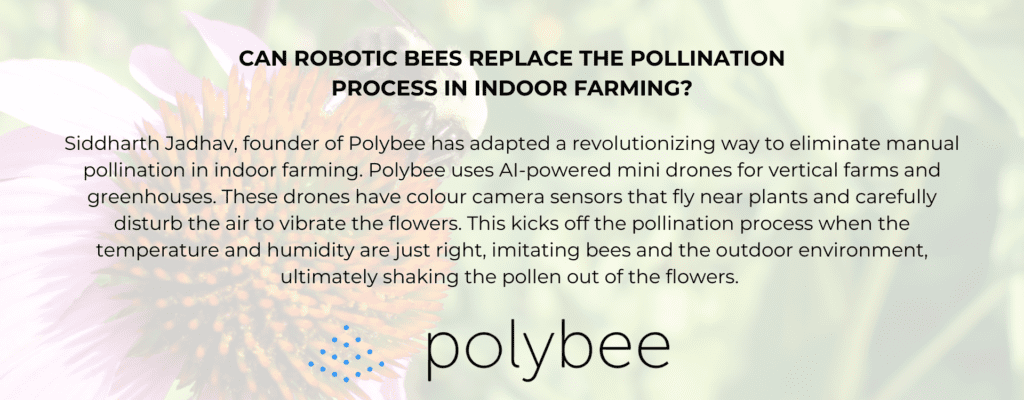
Pollination in Indoor Farming: Enhancing Growth with LED Grow Lights
As many know, pollination is a critical process for the reproduction of many plants, but what is the process in a tightly controlled environment? Today we’re going to be discussing how plants go through pollination when indoor farming! In the absence of natural pollinators like bees, wind, and birds, indoor farmers must take matters into their own hands to ensure successful cultivation. Believe it or not, strategies to enhance indoor pollination include everything from your grow lights to manual pollination or even AI pollination. All of these factors combined offer a solution that not only supports the pollination process but also ensures a healthy and happy indoor crop.
KNOW YOUR CROP
Indoor crops, like outdoor, require pollination to bloom successfully and produce fruit. It is important to identify the type of pollinated plant you intend to cultivate indoors before choosing a pollination method.

Insect-pollinated plants are the most common. These plants often have bright flowers, nectar, and a pleasing aroma that attracts these pollinators. Approximately 75-95% of flowering plants are pollinated by animals, primarily insects.
Wind-pollinated plants rely on the wind to carry the pollen from one plant to another. These plants produce large amounts of pollen, like grass and wheat, and make up 10-20% of pollinators.
Bird-pollinated plants attract mostly hummingbirds because of their tubular flowers and large amounts of nectar, making up only 5% of flowering plants.
Bat-pollinated plants make up only 1% of pollination; these plants open their flowers only at night. They have a strong smell and large, pale flowers to attract nocturnal bats.
Water-pollinated plants rely on water to move their pollen and are mainly found in aquatic plants.
Self-pollinated plants don’t need external pollinators to pollinate outdoors, as they often have flowers that can close tight and produce pollen, ensuring reproduction without pollinators. This pollination process is common in plants like peas and beans. Self-pollinators still rely heavily on their environment to reproduce so they will likely require manual pollination indoors.
OPTIMIZING YOUR INDOOR ENVIRONMENT
To achieve success in indoor farming, it is important to have the right LED grow lights for your specific environment and crop. LED grow lights are beneficial during the pollination phase because some plants require specific light wavelengths to open their flowers, which is necessary for pollination to occur. LEDs can be programmed to emit these wavelengths, encouraging flowers to open and making them more accessible for pollination. Aelius LED has a variety of plug-and-play fixtures that help provide the optimal environment for pollination. The intensity and duration of LED light exposure can be adjusted to simulate the optimal conditions for pollination.

For example, certain crops may benefit from increased blue light, which has been shown to simulate stamen movement and enhance the release of pollen. This can be very useful for self-pollinating plants, where the pollen needs to move from the anther to the stigma within the same flower.
As we all know by now, LEDs emit less heat compared to traditional grow lights, and this is important because excessive heat can damage the pollen and reduce its viability. Maintaining the right levels of humidity is also crucial since having too much moisture can cause the pollen to clump together, while too little can dry it out and make it less likely to stick to the stigma. Grow lights can enhance biodiversity within the indoor ecosystem since they support the growth of pollinator-friendly plants that attract insects when they are put into indoor farms.
MANUAL POLLINATION
Once the plant is ready, farmers need to put in the manual efforts to complete pollination. Techniques such as using a small paintbrush or cotton swab to transfer pollen from one flower to another are common practices among indoor farmers. Some indoor farmers even use small vibrating tools to mimic the buzz pollination technique used by bees, which can increase the process of pollen transfer.
POLYBEE
Manual pollination has always been the key to successfully pollinating indoor crops. However, as technology advances, there are other options like polybee, that use AI to power mini drones designed to delicately vibrate plants- saving time and collecting valuable data during the process.

Learn more about polybee here: https://www.youtube.com/watch?v=BEtAIXGm4GA
The integration of LED grow lights and creative technology for pollination in indoor farming is proof of the innovative approaches being developed in modern agriculture. Having this balance of light, environment, and pollination techniques ensures that even without natural pollinators, we will be able to have success indoors with the most difficult crops.




